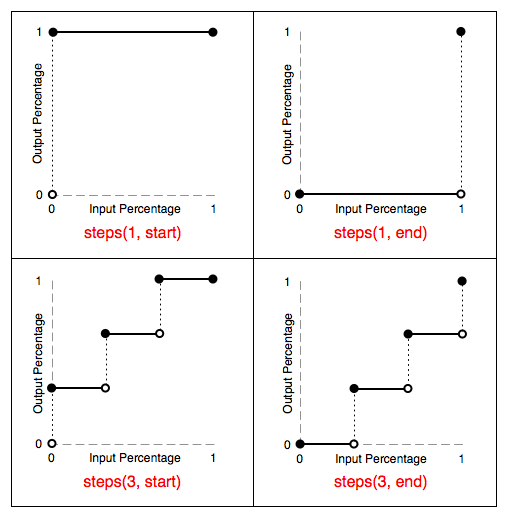# 动画线性时间曲线
animation-timing-function是控制时间的属性 常见的属性有

# steps 属性
animation默认以ease方式过渡 它会在每个关键帧之间插入补间动画 所以动画效果是连贯性的关键帧之间的跳跃 则需要使用steps过渡方式
steps的测试案例
<!DOCTYPE html> <html> <head> <meta charset="UTF-8"> <title></title> <style type="text/css"> div { height: 100px; position: absolute; left: 0; } .div_static { width: 600px; background-color: #000000; top: 10%; } .div_move { width: 100px; animation: melon 3s infinite steps(3); /*animation: melon 2s infinite step-start;*/ top: 30%; background-color: #87CEEB; } @keyframes melon { 0% { left: 0; } 20% { left: 100px; } 40% { left: 200px; } 60% { left: 300px; } 80% { left: 400px; } 100% { left: 500px; } } </style> </head> <body> <div class="div_static"></div> <div class="div_move"></div> </body> </html>1
2
3
4
5
6
7
8
9
10
11
12
13
14
15
16
17
18
19
20
21
22
23
24
25
26
27
28
29
30
31
32
33
34
35
36
37
38
39
40
41
42
43
44
45
46
47
48
49
50
51
52
53
54
55
56
57
58
59
60
61
62
# 总结
steps(x,start|end)的第一个参数是指时间函数中的间隔数量(必须是正整数)steps(start,x)是指在第一步中又一次分割x次进行动画 而不是指从第x开始执行 也不是指整个动画的变化次数step-start等同于steps(1,start)会忽略第一步 即从第二步开始执行直到最后step-end等同于steps(1,end)会忽略最后一步 即从第一步开始执行直到倒数第二步step的工作机制图
最后再次强调:timing-function 作用于每两个关键帧之间,而不是整个动画